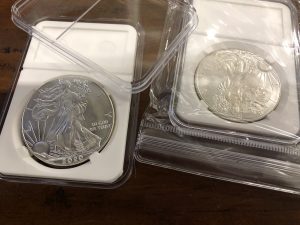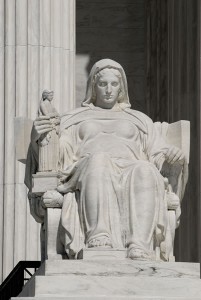Weekly World Numismatic News for October 25, 2020
I have tried my best to get the word out to as many people as possible, including the media. I spent a few hours scouring the Internet for the consumer reporters’ addresses in as many major markets as possible, even sending messages to competing stations. Nobody has responded.
Even though high traffic and Google statistics tracking has pushed the blog closer to the top of the search when people inquire about counterfeit American Silver Eagles, the fact remains that it is difficult or a one-man crusade to cut through the daily noise.
It would have been nice if I had help. I did post warnings on the ANA’s Facebook group. Even though there are Board members involved with the Facebook group, nobody has picked up the ball and tried to put the force of the ANA behind an educational campaign.
The email sent about these fake coins add up to over 150 counterfeit coins. Although it is a small fraction of the total American Silver Eagle population, counterfeits in the market can potentially turn potential collectors into someone who does not trust the market.
I will continue my part of the fight.
Other than the posts I made about these coins, I compiled a list of the websites identified by readers as selling counterfeit American Silver Eagle coins. Once I created the list, I checked the sites to see if they are still selling fakes.
Readers can find the list of dealers selling fake coins at coinsblog.ws/fakes. I will maintain that list with the information as I receive it. Maybe if we work together, we can educate the public and eliminate the demand these scammers use to dupe people.
And now the news…
 → Read more at millstonenews.com
→ Read more at millstonenews.com
 → Read more at expressandstar.com
→ Read more at expressandstar.com
 → Read more at jerseyeveningpost.com
→ Read more at jerseyeveningpost.com
 → Read more at calaverasenterprise.com
→ Read more at calaverasenterprise.com
A look inside the U.S. Mint at West Point
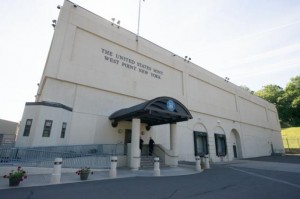 This year, the U.S. Mint Facility at West Point, New York turn 75 years old. When opened in 1937, it was to be the nation’s silver bullion depository giving it the nickname “The Fort Knox of Silver.” In 1988, West Point was granted mint status.
This year, the U.S. Mint Facility at West Point, New York turn 75 years old. When opened in 1937, it was to be the nation’s silver bullion depository giving it the nickname “The Fort Knox of Silver.” In 1988, West Point was granted mint status.
The “W” mintmark on U.S. coins is highly prized since it is the only mint not to strike circulating coins with its own mintmark. While the West Point Mint did strike cents from 1973 through 1986, the coins produced were not struck with a mintmark.
Today, the West Point Mint only strikes precious metal coins. From commemoratives through bullion American Eagle coins, West Point produces more precious metal coins than any other Mint in the world, including the San Francisco Mint.
Located just outside the United States Military Academy, the West Point Mint does not allow visitors or tours for security reasons. However, exceptions are made. With the facility celebrating its 75th anniversary, the U.S. Mint has been allowing journalists to visit and take pictures of their operations.
Thus far, the best set of images were published in the Daily News. In the article, “West Point Mint, with $80 billion in precious metals, celebrates 75th anniversary,” the reporters visit the West Point Mint and bring back some very interesting picture. You can read the story on the Daily News’s website or if you just want to see the pictures, you can see this board I created on Pinterest.
The Daily News also created a two-minute video looking inside the facility. The video follows (if it begins with a commercial, it is being sent by the Daily News—the cost of embedding their video):
If you are having problems seeing the video, go here.
All images and the video courtesy of the Daily News.
Unintended consequences
Franklin Delano Roosevelt was inaugurated on March 4, 1933 at the height of the Great Depression. Unemployment was over 25-percent, inflations was rampant, farm prices have plummeted so low that it was cheaper for farmers to plow under crops, and banks were failing at record numbers.
Two weeks prior to his inauguration, FDR asked his old friend and Wall Street executive William H. Woodin, to be the Secretary of the Treasury and help implement a new monetary policy. Woodin rushed to Washington to work with Ogden Mills, President Herbert Hoover’s Secretary of the Treasury, in order to understand the issues. On the day of FDR’s inauguration, Mills resigned and voluntarily stayed in Washington to help Woodin with various policy changes.
Hours after FDR’s inauguration, the Senate approved the appointment of Woodin as the Secretary of the Treasury. With his new Treasury Secretary in place, Woodin’s first act was to declare a three-day bank holiday in order to try to stop the failures.
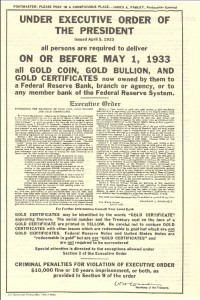
Handbill that was displayed in Post Offices calling for the recall of gold with the text of Executive Order 6102
Executive Order 6102 specifically exempted certain industrial uses of gold, art, and allowed people to keep up to $100 in face value in gold coins. It also exempted “gold coins having recognized special value to collectors of rare and unusual coins.” The protection of collectible coins was credited to Woodin since he was a collector of coins and patterns he acquired while director of the New York Federal Reserve Bank.
Although most of the country complied with the executive order, some challenged the law and started to sue the government to stop the gold recall. With the challenges mounting, on June 5, 1933, congress formally takes the United States off the gold standard by enacting a joint resolution (48 Stat. 112) nullifying the right of creditors to demand payment in gold.
For weeks after FDR issued EO 6102, the U.S. Mint continued strike gold double eagle coins because they did not have an order to stop. After receiving the stop work order, the coins were stored until they were ordered melted in 1934.
Even though the double eagles were melted, several examples of the 1933 Saint Gaudens double eagle gold coin did find its way out of the Mint. While most were tracked and confiscated, one example found its way to Egypt into the collection of King Farouk. This was the coin that eventually was sold in 2002 for $7,590,020 ($20 given to the government to monetize the coin) to a private collector. Half of the proceeds were paid to the government as part of a settlement with British coin dealer Stephen Fenton, who was arrested trying to sell the coin at the Waldorf Astoria Hotel in 1998.
-
Reverse of the iconic 1933 Saint Gaudens
$20 Double Eagle gold coin
But that does not end the story of the 1933 Saint Gaudens double eagle. Since the sale of the only legal tender 1933 Double Eagle, ten coins found by the family of the late jeweler and coin dealer Israel Switt. The coins were sent to the U.S. Mint for authentication and were subsequently confiscated when they were determined to be genuine.
These coins are known as the “Langboard Hoard,” named for Joan Landbord, the daughter of Israel Switt, who claims to have found the coins while searching through her father’s old goods. On more than one occasion, Switt has been accused of being the source of the 1933 Double Eagle coins that made it out of the Philadelphia Mint.
In July 2011, a jury ruled that the 10 coins in the Langboard Hoard belong to the government. The case is currently being appealed.
The story of 1933 Saint Gaudens double eagle is truly an example of the law of unintended consequences. In an effort to rescue the economy, the cascading series of events that took the United States off the gold standard turned what was supposed to be an ordinary coin into one of the most intriguing stories of the 20th and now 21st century.
All images courtesy of Wikimedia Commons.
What is Shepherd really up to?
I know I have not been writing a lot as of late. Those of us in the Washington, D.C. area know the problems that sequestration has caused on government agencies. It might take another month before we regain a rhythm that will allow me to plan my time better. I have a nice To-Do list of stories I want to post including four book reviews and a few iPhone apps that are interesting.
I also do not want to use this blog as a campaign vehicle because that would be boring for you to read and for me to write. But when something as big as the most recent news comes out and I am asked for a comment, I have no choice but to use this blog to answer the many email inquiries once so we can get on with life.
Yesterday, the latest edition of Coin World began to appear in mailboxes. I knew this when I received several email notes about the article describing the amended lawsuit by former American Numismatic Association Executive Director Larry Shepherd. I opened the digital version of Coin World (the article is not online, yet), read the article with my mouth open, and found a link at the end of the story where you can download the amended complaint. I downloadedand read the amended complaint. [PDF]The amended complaint is shocking and salacious. For those not familiar with the law and read that Shepherd is accusing the ANA of being a Racketeer Influenced and Corrupt Organization (RICO; 18 U.S.C. Chapter 96), it makes it look like the ANA is being compared to any number of organized crime figures you might have read about in the newspapers. Even though the RICO statutes were written to fight organized crime, using it is a common tactic by plaintiff lawyers to scare the defendants they are suing.
In order for a RICO charge to be accepted by the court, Shepherd and his lawyers will have to prove that a person as a member of an enterprise or the enterprise itself has committed to of 35 different crimes (18 U.S.C. § 1961). The crimes that Shepherd is alleging that the ANA has committed are racketeering, theft, and fraud.
Racketeering sounds like an ominous charge. Racketeering is a crime when two or more people conspire to fraudulently solve a problem. Shepherd alleges that a few employees of the ANA and members of the Board of Governors made up stories about Shepherd in order to find a way to relieve him of his duties for cause so they can invalidate his contract. The stories are salacious in nature and constitute Shepherd’s accusation of defamation that allows him to attach others to the case to show that there were more than two people involved.
The theft charge is from the guilty plea by former collections manager Wyatt Yeager. In January 2012, Yeager plead guilty to stealing items from the ANA Money Museum worth nearly $1 million. Yeager was sentenced to 27 months in a federal prison, two years of supervised probation, and ordered to pay restitution to the ANA.
With the theft charges already verified by a criminal court, Shepherd has to prove that the ANA committed fraud and at least two of the co-defendants conspired to fraudulently have him dismissed to resolve whatever issues the co-defendants perceived hurt the ANA. That would prove the case under RICO and hold the co-defendants and the ANA liable for Shepherd’s dismissal.
If you decide to read the pleading please remember that it is one side of the story. While the accusations are salacious and disturbing, we have not heard from the ANA or the co-defendants. This is a stark contrast to how they handled Shepherd’s dismissal when they could not stop talking. However, the ANA has a new general counsel who may be a little more cautious than the previous general counsel. The previous general counsel, Ron Sirna, is a co-defendant on this lawsuit.
Shepherd’s charges against the ANA and the co-defendants are disturbing. In fact, the nature of the salacious accusations is disturbing. If there is any truth in these accusations, those involved must be disciplined. Employees involved should be required to undergo remediation to keep their jobs or be dismissed if their action crossed the legal line.
According to the ANA Code of Ethics, members are required to “To base all of my dealings on the highest plane of justice, fairness and morality, and to refrain from making false statements as to the condition of a coin or as to any other matter.” Any member found to have be part of the racketeering that Shepherd’s lawsuit alleges, should be subject to an ethics review.
I was recently reminded of a quote from Inferno, the first part of Dante Alighieri’s epic poem The Devine Comedy: “The darkest places in hell are reserved for those who maintain their neutrality in times of moral crisis.” Therefore, members of the Board of Governors who did not “report any knowledge of waste, fraud, corruption or impropriety relating to the Association to all other Board members immediately upon learning thereof” (Code of Ethics, Section 12) should also be subject to an ethics review.
Shepherd is also not absolved from his part. While he may have a legitimate case, his timing is suspect. Why did he wait until the beginning of the election to amend his complaint laced with descriptions of salacious accusations at this time? Shepherd has to remember that while he makes accusations, it takes two to tango, which means that he may have had a part in acts that the pleading describes. It is also possible that Shepherd and his attorneys picked only examples that are in his favor. Until the ANA answers the charges levied by Shepherd we are left wondering what was left out?
The bottom line is that it is time to clean house. ANA members must elect a Board of Governors that will act more like a Board of Directors. People who will be professional, open, and work for the benefit of the ANA. The Board of Governors must treat the association like the $6 million business it is and set up programs for the professional office to support the association for the benefit of the members and not the benefit of the staff. While there may be a few people with issues, as described in Shepherd’s pleading, those few people are making the situation difficult for those who are doing a wonderful job.
If I am privileged to receive enough votes to be elected to the Board of Governors, I renew the promise I made previously that the first motion I will make will be to hire an executive management firm that has a verifiable background in helping non-profit organizations to review the entire ANA management structure. This stuff has to stop so that we can get on with the business of building our collections with all of the advantages the ANA can provide us, the members.
Image from Photographs from the Supreme Court’s Collection.
Summary of May 2013 Coin-Related Legislation
H.R. 1905: Mother’s Day Centennial Commemorative Coin Act
Sponsor: Rep. David McKinley (R-WV)
• Introduced: May 9, 2013
• Referred to the House Committee on Financial Services
Track this bill at http://www.govtrack.us/congress/bills/113/hr1905
H.R. 1071: To specify the size of the precious-metal blanks that will be used in the production of the National Baseball Hall of Fame commemorative coins.
Sponsor: Rep. Richard Hanna (R-NY)
• This bill is a technical change to the National Baseball Hall of Fame Commemorative Coin Act.
• Signed by the President on May 17, 213
• This bill became Public Law 113-10
See the information about this bill at http://www.govtrack.us/congress/bills/113/hr1071
S. 1011: Boys Town Centennial Commemorative Coin Act
Sponsor: Sen. Mike Johanns (R-NE)
• A bill to require the Secretary of the Treasury to mint coins in commemoration of the centennial of Boys Town
• Introduced: May 22, 2013
• Referred to the Senate Committee on Finance
Track this bill at http://www.govtrack.us/congress/bills/113/s1011
Voting has begun!
By now, those who are eligible to vote for the American Numismatic Association Board of Governors have either received their paper ballot or the information with instructions how to vote electronically. Please remember that all ballots are due back to the auditor by June 30, 2013.
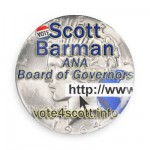 For previous elections, I made it a point to learn about the candidates and provided readers with my endorsements and why I endorsed those candidates. Since I am on the ballot, I will not endorse any other candidate this year. I ask that my readers consider my candidacy and those who commit to growing the ANA through honesty, integrity, and a heavy dose to technology in order to attract collectors under 50-years old. Those potential members are the association’s future.
For previous elections, I made it a point to learn about the candidates and provided readers with my endorsements and why I endorsed those candidates. Since I am on the ballot, I will not endorse any other candidate this year. I ask that my readers consider my candidacy and those who commit to growing the ANA through honesty, integrity, and a heavy dose to technology in order to attract collectors under 50-years old. Those potential members are the association’s future.
Last night, I posted a letter to ANA members on my election website, vote4scott.info. Please read it and if you have any question, drop me a note. I will be more than happy to discuss any of your concerns.
Thank you!
